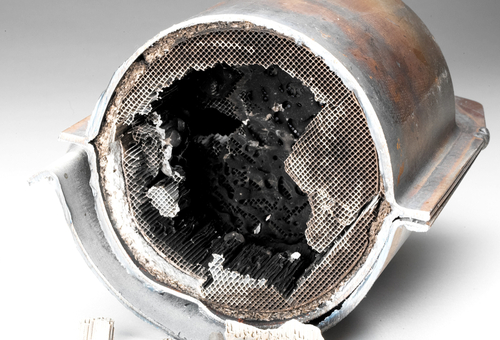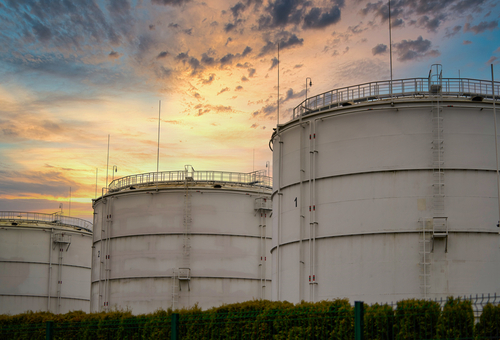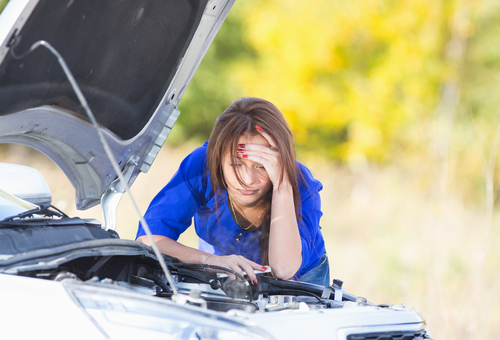
Have you ever wondered about the real reasons why we see catalytic converter efficiency codes P0420 and P0430 as often as we do? More to the point, though, what do you tell customers when their new catalytic converters fail (yet again) well within their legally mandated 160 000km “warranty” period?
These are not idle or rhetorical questions. The issue of premature catalytic failures was again brought to the fore for this writer recently when he encountered six premature catalytic converter failures on different vehicles in the space of a single week. Six such failures in one week is admittedly unusual, but still, most of us, or at least, many of us see codes P0420 and P0430 more often than almost any other code.
So, what is the root cause of premature catalytic converter failures in Australia? Is it simply because Australian catalytic converters are bad, or are other factors involved? To be fair, catalytic converters in other markets also fail, but available data shows that the failure rate in Australia is considerably higher than in other developed markets, so in this article, we will discuss some issues around premature catalytic converter failures in Australia. Before we get to specifics, though, let us start by looking at-
Some of the most difficult conversations with customers this writer has ever had revolved around attempts to persuade some customers that in some cases, the internet is wrong about certain things.
To be sure, countless online resources provide accurate, relevant, and reliable service and diagnostic information to the global independent car repair industry. After all, many of us use these resources almost daily, and we are even prepared to buy expensive subscriptions to maintain our access to this information.
However, few members of the public are prepared to go to these lengths to access reliable information, so the general public is largely left with consumer-facing resources that (very) frequently provide fragmented, incomplete, and sometimes, downright wrong and/or misleading information. As a result, most of the public is unable to distinguish between professional-level information and useless information that is often copied from one resource to hundreds of others. This is not because our customers are stupid; it is because-
So what does all, or any of the above mean in the real world that we technicians inhabit? It simply means this: if you are not in a management position that exposes you to the public, you may not be in a position to appreciate the level of frustration some customers experience when they are told that the resource they used to “diagnose” their catalytic converter issues is just plain dead wrong. Moreover, you may also not realize just how limited car maintenance budgets have become for many of our customers.
Therefore, you may not appreciate the levels of self-induced stress some customers experience when an online resource casually mentions “serious mechanical issues in the engine” as a cause of catalytic converter failure- and especially when those customers resorted to an online self-diagnosis because they cannot afford a professional evaluation or assessment of their catalytic converter problem(s).
It should be noted though that it is not the intention of this article to belittle or denigrate any consumer-facing resource for the quality of the information it provides, regardless of the market it serves. Nonetheless, it must be said that from the perspective of average car owners looking for relevant advice about car problems, some resources do nothing more than take up bandwidth. Let us look at one practical example of-
As far as catalytic converters go, many customers have no to little hesitation in quoting the advice of keyboard experts. For example, one of the customers that suffered a premature catalytic converter failure mentioned earlier quoted a supposedly professional mechanic that discusses catalytic converter failures. Here is the short version of this discussion, but bear with us, the point of this will become clear a bit later on-
The most common P0420 and P0430 cause is a clogged catalytic converter filter, which requires replacing the entire catalytic converter. (This is reproduced verbatim from the relevant page)
The post then goes on to list other possible causes, including-
In the interest of fairness, it must be stated that while most of the items listed above are, or can be, legitimate causes of catalytic converter failures, the part about or “…oil or coolant getting into the exhaust because they weren’t changed”, represents an insight that this writer is particularly interested in learning more about.
Nonetheless, the point of the above list is that it is an adapted version of a “Top 10 List of Catalytic Converter Failures” that exists in hundreds of iterations on countless consumer-facing resources. Although this is not a problem in itself, it is nevertheless a problem for consumers because-
So, what would you, a professional technician, tell customers when they quote a list of probable causes of premature catalytic converter failure, such as the one presented here, at you? Will you-
Of course, we should always tell our customers what serves their interests best, and from that perspective, any of the above responses would be appropriate. However, in the Australian context, we would suggest that your customer’s interest are best served if we tell them that despite the probable causes listed above, the most likely cause of repeated premature catalytic converter failures involves-

It would be fair to say that we all know that the quality and cleanliness of Australian petrol is not what it should be, and in this article, https://www.mechanic.com.au/news/the-problem-in-the-fuel-tank, we discussed this topic in some detail.
However, this article mentions the relationship between poor fuel quality and premature catalytic converter failure only in passing, so to put the issue of just how bad our petrol is into proper perspective, we need to look at a) efforts to improve fuel quality in other markets, and b), the results of those efforts. Let us start with-
In January 1999, the Federal Government of America passed a law known as the Clean Gasoline Act of 1999 as a means to address the issue of excessive exhaust emissions released by petrol engines. This law is too long to reproduce here, so we will only quote some of its most relevant parts.
The Clean Gasoline Act of 1999 starts by stating the problem as it stood in 1999, so consider the following-
In sections 4 (A), it states that-
Gasoline sulphur levels in the United States--
(i) Average between 300 and 350 ppm (parts per million) and range as high as 1000 ppm
(ii) [Which] are far higher than the levels allowed in many other industrialized nations and higher than the levels allowed by some developing nations
(B) The European Union recently approved a standard of 150 ppm to take effect in 2000, to be phased down to 30 through 50 ppm by 2005
(C) Japan has a standard of 50 ppm [in 1999]
(D) Gasoline and diesel fuel in Australia, New Zealand, Taiwan, Hong Kong, Thailand, and Finland have significantly lower sulphur concentrations than comparable gasoline and diesel fuel in the United States. (Italics and bolding added for emphasis)
Section 2 of the Clean Gasoline Act of 1999 states that-
(A) Failure to control gasoline sulphur concentration adversely affects catalytic converter function for all vehicles in the national vehicle fleet
(B) Research performed collaboratively by the auto and oil industries demonstrates that when [the] sulphur concentration in motor vehicle gasoline is reduced from 450 parts per million (referred to in this section as ``ppm'') to 50 ppm--
(i) Hydrocarbon emissions are reduced by 18 percent
(ii) Carbon monoxide emissions are reduced by 19 percent
(iii) Nitrogen oxide emissions are reduced by 8 percent
Section 3 of the Clean Gasoline Act of 1999 states (inter alia) that
(3) (A) Recent studies conducted by the Association of International Automobile Manufacturers, and the Coordinating Research Council confirm that sulphur in vehicle fuel impairs to an even greater degree the emission controls of Low-Emission Vehicles (referred to in this section as ``LEVs'') and Ultra-Low-Emission Vehicles (referred to in this section as ``ULEVs''; (Source: https://www.govinfo.gov/content/pkg/BILLS-106s171is/html/BILLS-106s171is.htm )
It is interesting to note that hydrocarbons, carbon monoxide, and nitrogen oxide are the pollutants that catalytic converters are expressly designed and intended to reduce, if not eliminate. Thus, the reduction of the sulphur content of petrol in the US market from 1000 ppm to 450 ppm and from there to 50 ppm, produced two effects, these effects being-
However, starting in 2017, additional legislation, known as the "LDV Emissions program", states that-
“[The] EPA (Environmental Protection Agency) requires that federal gasoline will contain an average of 10-ppm sulphur on an annual basis, with the maximum sulphur [content] allowed per batch remaining at 80 ppm at the refinery gate and 95 ppm downstream. EPA has offered flexibility in phase-in of these sulphur standards at each stage, temporarily allowing for compliance with less stringent standards by small refiners or small volume refiners in 2004-2006, 2006-2007, and again during 2017-2020.” (Source: http://www.transportpolicy.net/standard/us-light-duty-emissions/ )
So what does any of the above have to do with the quality and sulphur content of Australian petrol? The answer is complicated, but for the most part, the issue of high-sulphur petrol in Australia involves-
According to the Fuel Quality Standards (Petrol) Determination 2019, the maximum allowable sulphur content of 91 RON grade petrol in Australia is 150 ppm*, while the sulphur content of 95 RON grade petrol is capped at 50 ppm, to, as the Determination puts it, “…clean up the noxious exhaust gases produced by petrol engines.”
* Note that the Determination also states that these values will be in force until the end of June in 2027 when the next review of petrol standards is expected to occur. Note also that while the Determination gives these values in mg/kg, this unit of measurement is the exact equivalent of “parts per million”.
So what’s the problem? The problem is that while Australia currently enforces Euro 5 exhaust emissions standards, the high sulphur content of Australian petrol translates into the fact that many, if not most cars on Australia’s roads barely meet Euro 4 standards, let alone Euro 5 standards.
There is more, though. Consider this statement in an official Federal Government document that was published in 2011-
“The 150 ppm sulphur limit currently applying to regular unleaded petrol (91 RON) is higher than the limits now applying in most advanced markets, and the RIS sought input from stakeholders on whether this presents a barrier to compliance with Euro 5/6 standards.
The FCAI (Federal Chamber of Automotive Industries) and all [other] vehicle industry submissions argued that the 150-ppm level was too high, while the oil industry, represented by the AIP [Australian Institute of Petroleum], argued that-
“… there is no evidence that even 150ppm sulphur is a problem. The RIS did not identify any evidence that the 150-ppm sulphur level in ULP is a barrier to supplying Euro 5 compliant petrol vehicles to the market, and the public submissions provided no evidence to the contrary.”
As a result of the contradictory views expressed here, the authors of the document concluded that-
“There is less certainty over the impact of 150 ppm sulphur on the durability and longevity of emission control systems in petrol vehicles (such as catalysts)”. (Source: Vehicle Standard (Australian Design Rule 79/04 - Emission Control for Light Vehicles) 2011 (Italics added for emphasis)
Now consider the following statements and findings of a research study titled, FUEL QUALITY AND EMISSIONS STANDARDS IN AUSTRALIA that was commissioned by the Commonwealth of Australia Department of Infrastructure and Regional Development ADVISORY SERVICES. This study was intended to investigate the Fuel Sulfur Impacts on Euro 6 Compliance and was published in 2016-
Among other things, this study says that-
“We do know that the USA has an average [of] 30 ppm sulphur and that there have not been any reported issues of early mortality in the OBD or the emission systems." (Source: https://www.infrastructure.gov.au/vehicles/environment/forum/files/IHS_Markit_Report_2016.pdf)
Briefly, though, this study had to answer several other questions, including-
[“Determining] the highest level of sulphur in petrol that could be used to operate vehicles in typical conditions without significant risk of exceeding the Euro-6 on-board diagnostic (OBD) system thresholds within the 160,000 km durability period.” (Source: https://www.infrastructure.gov.au/vehicles/environment/forum/files/IHS_Markit_Report_2016.pdf )
The study found that-
High sulphur levels (+50 ppm) will inhibit the Emission Control Technologies* from making [it to]the 160,000 km milestone. Italics added for emphasis. (Source: https://www.infrastructure.gov.au/vehicles/environment/forum/files/IHS_Markit_Report_2016.pdf)
* In this context, “Emission Control Technologies” include, but are not limited to, catalytic converters.
This particular finding definitively refutes the following statements contained in the Vehicle Standard (Australian Design Rule 79/04 - Emission Control for Light Vehicles) 2011-
1) “…The FCAI (Federal Chamber of Automotive Industries) submission also claims that some manufacturers of Euro 5 vehicles are "desensitising" their OBD systems because the sulphur levels are above 10ppm. However, no supporting information was provided to substantiate these statements.”
2) “…In contrast, the AIP submission, quoting a number of published reports, argues that there is no strong evidence to warrant a change in current sulphur levels in either 91 RON or 95 RON petrol, stating that "most prospective vehicle technologies can operate satisfactorily on...150ppm sulphur" and that "150ppm ULP...is not an impediment to the introduction of Euro 5/6”.
As a practical matter, this last statement directly contradicts objective research that was done in the US market as long ago as the late 1990s, and which established an irrefutable link between high sulphur concentrations in petrol and premature catalytic converter failure.
Moreover, how likely is that that some global carmakers will go to the trouble, and bear the cost of "desensitizing”, or de-tuning their engine management systems? It seems highly unlikely, given that in 2019, the total Australian market for new light vehicles accounted for only 799263 units, whereas China, the world’s biggest market, moved more than 21 million units. In fact, in 2019, the Australian car market ranked at a lowly number 13 on a global scale. Source: (https://www.theglobaleconomy.com/rankings/passenger_cars_sales/#Australia)
All of the above raises a very important question, this question being-

As a practical matter, Australian car owners are deprived not only of the latest emission control mechanisms/systems but also of the benefits of advanced engine designs and improved engine management systems. This is simply because the ultra-low emission engines that are common in most other developed markets cannot run efficiently on Australian petrol.
Thus, if we accept the assertion made by the fuel/oil industry that some car manufacturers are somehow de-tuning ultra-low emission engines to run on high-sulphur petrol, then we must accept that vehicles destined for the Australian market are inferior to similar vehicles sold in other developed markets.
However, if we do not accept that Australian vehicles are somehow detuned, then we must accept that one of the primary causes of the high incidence of premature catalytic converter failure is the poor quality of Australian petrol.
Either way, the average Australian car owner is being short-changed in the worst possible way, and the fact that catalytic converters that fail prematurely are usually (but not always) replaced under warranty conditions, is but a small consolation, which leaves us with this-
While it is certain that a significant percentage of premature catalytic converter failures are directly related to the poor quality of our petrol, this does not absolve of the responsibility to perform proper and valid diagnostics every time we encounter a catalytic converter failure.
We still need to investigate all the possible and probable causes of the failure. For example, we know that some engines are oil guzzlers by nature and we know that excessive oil consumption can, and does catalysts to fail. Similarly, defective/faulty fuel injectors can destroy a catalytic converter in very short order. There are many other possible causes of premature catalytic converter failure, so it is not good enough simply to blame all catalytic converters failures on bad fuel.
Nonetheless, until the sulphur content of petrol is reduced to levels that match the standards in most other developed automotive markets, we will continue to see large numbers of catalytic converters of types fail well within their warranty periods. While there is nothing we, as technicians, can do about that, there are nevertheless some things we can, and should do.
For instance, we could tell our customers to avoid replacing a failed catalytic converter with a so-called “rebuilt”, “refurbished”, “cleaned”, or otherwise “repaired” catalytic converter. There is no reliable way to clean or repair catalytic converters designed for use on light vehicles. “Reconditioned” catalytic converters might be substantially cheaper than OEM or even OEM-equivalent units, but they typically fail completely in very short order, since they were already inefficient, to begin with.
We could also tell our customers to avoid so-called fuel system cleaners in attempts to resuscitate a dying catalytic converter. Since some of these additives contain sulphur-based compounds that are intended to lubricate the moving parts in fuel injectors, adding sulphur to fuel that already contains high levels of sulphur will only hasten the death of the catalytic converter they are trying to save.
We have one more suggestion. We recommend that you read the documents referenced in this article in their entirety to give you a better idea of the true impact of bad fuel on the vehicles we see in our bays every day. Once you see the proverbial "big picture", we guarantee that you will see at least some previously “undiagnosed-able” issues with high fuel consumption and general drivability issues in an entirely new light.